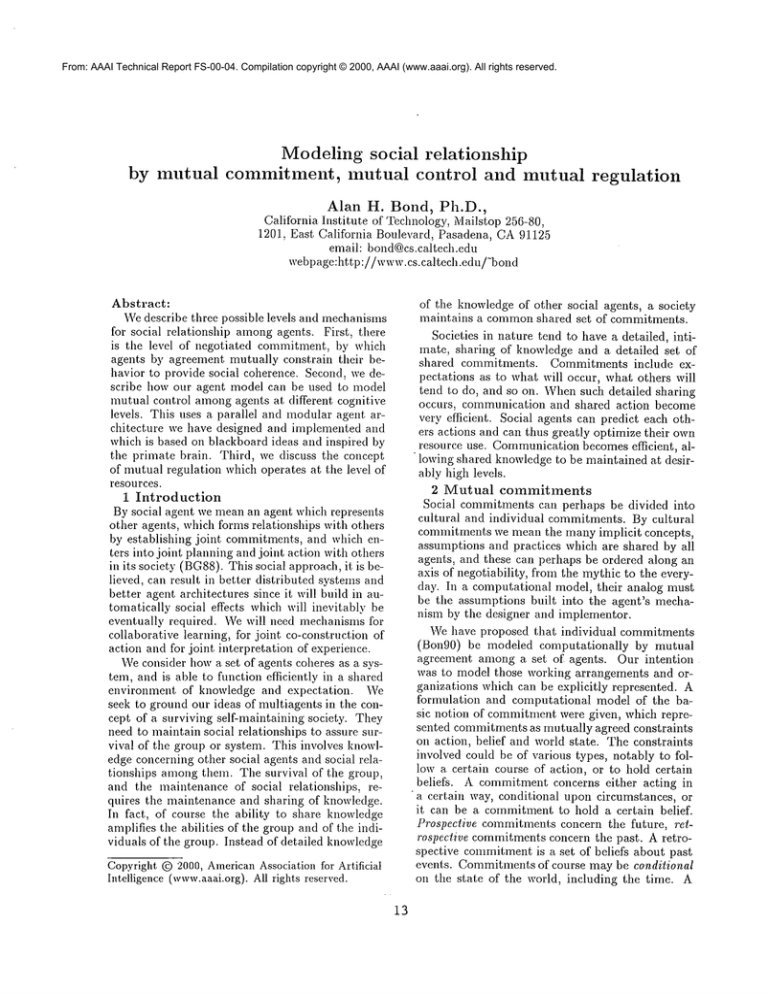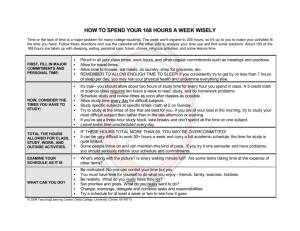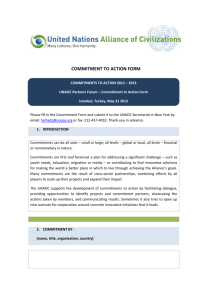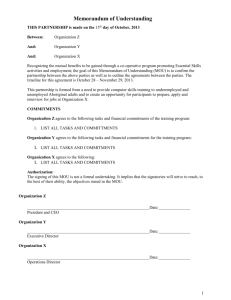
From: AAAI Technical Report FS-00-04. Compilation copyright © 2000, AAAI (www.aaai.org). All rights reserved.
Modeling social relationship
by mutual commitment, nmtual control and mutual regulation
Alan H. Bond, Ph.D.,
California Institute of Technology, Mailstop 256-80,
1201, East California Boulevard, Pasadena, CA91125
emaih bond@cs.cMtech.edu
webpage:http ://www.cs.caltech.edu/%ond
Abstract:
Wedescribe three possible levels and mechanisms
for social relationship amongagents. First, there
is the level of negotiated commitment, by which
agents by agreement mutually constrain their behavior to provide social coherence. Second, we describe how our agent model can be used to model
nmtual control amongagents at different cognitive
levels. This uses a parallel and modular agent architecture we have designed and implemented and
which is based on blackboard ideas and inspired by
the primate brain. Third, we discuss the concept
of nmtual regulation which operates at the level of
resources.
1 Introduction
By social agent we mean an agent which represents
other agents, which forms relationships with others
by establishing joint cominitments, and which enters into joint planning and joint action with others
in its society (BG88).This social approach, it is believed, can result in better distributed systems and
better agent architectures since it will build in automatically social effects which will inevitably be
eventually required. Wewill need mechanisms for
collaborative learning, for joint co-construction of
action and for joint interpretation of experience.
Weconsider howa set of agents coheres as a system, and is able to function efficiently in a shared
environment of knowledge and expectation.
We
seek to ground our ideas of multiagents in the concept of a surviving self-maintaining society. They
need to maintain social relationships to assure survival of the group or system. This involves knowledge concerning other social agents and social relationships amongthem. The survival of the group,
and the maintenance of social relationships,
requires the maintenance and sharing of knowledge.
In fact, of course the ability to share knowledge
amplifies the abilities of the group and of the individuals of the group. Instead of detailed knowledge
Copyright © 2000, AmericanAssociation for Artificial
Intelligence (www.aaai.org).All rights reserved.
13
of the knowledgeof other social agents, a society
maintains a commonshared set of commitments.
Societies in nature tend to have a detailed, intimate, sharing of knowledge and a detailed set. of
shared commitments. Commitments include expectations as to what will occur, what others will
tend to do, and so on. Whensuch detailed sharing
occurs, communication and shared action become
very efficient. Social agents can predict each others actions and can thus greatly optimize their own
resource use. Communicationbecomes efficient, al¯ lowing shared knowledgeto be maintained at desirably high levels.
2 Mutual
commitments
Social connnitments can perhaps be divided into
cultural and individual commitments. By cultural
commitments we mean the many implicit concepts,
assmnptions and practices which are shared by all
agents, and these can perhaps be ordered along an
axis of negotiability, from the mythic to the everyday. In a computational model, their analog must
be the assumptions built into the agent’s mechanism by the designer and implementor.
~’~% have proposed that individual commitments
(Bon90) be modeled computationally
by mutual
agreement among a set of agents. Our intention
was to model those working arrangements and organizations which can be explicitly represented. A
formulation and computational model of the basic notion of commitmentwere given, which represented commitmentsas mutually agreed constraints
on action, belief and world state. The constraints
involved could be of various types, notably to follow a certain course of action, or to hold certain
beliefs. A commitment concerns either acting in
a certain way, conditional upon circumstances, or
it can be a commitment to hold a certain belief.
Prospective commitments concern the future, retrospective commitmentsconcern the past,. A retrospective commitmentis a set of beliefs about past
events. Commitmentsof course may be conditional
on the state of the world, including the time. A
connnitment concerning another agent’s action or
belief call be called an expectation. Our concept
of conm~itment was that an agent is constructed
to abide by its commitments; they could only be
changed by renegotiation with the agents originally
involved ill creating the commitments.
Different coinputational mechanismsare required
for the realization of these concepts. First, we need
a negotiation mechanism by which agents can compute representations of constraints. Wehave ourselves only investigated logical negotiation, which
we take to be joint proof conducted under conditions of complete truth and trust. Second, we need
a inechanism for ensuring that commitmentsto action are carried out as agreed. Andthird, we need
every action of the agent to be automatically constrained by any agreed commitments on belief and
behavior. This latter is currently either extremely
expensive or nmst be limited to certain tractable
classes of constraint such as linear inequalities on
nulnerical variables, as in constraint logic programruing.
3 Mutual control
Weimplemented an architecture for a social agent
as a hierarchy of modules which are executed in
parallel, each modulecontaining a store of logical
descriptions and a set of rules which are executed in
parallel (Bon99). Figure 1 depicts the architecture
and its relation to the primate brain.
The action of this architecture is for each agent to
continuously generate goals and from these to continuously select and instantiate a join! plan. Wedefine a joint plan as a set of joint plan steps governed
by temporal ordering and causality relations. One
joint plan step contains descriptions of actions for
each of a set of cooperating agents. This step is executed by perceiving the other cooperating agents
and instanting variables from the percept, and then
instantiating, elaborating and executing the corresponding action for the subject agent.
The architecture forms a perception-action hierarchy, so that perception and action is described
by expressions at several levels which condition one
another. Thus action is conditioned by the current
percept at the same level of abstraction, and perception is focussed by the requirements of action at
the same level. The joint action is "voluntary" or
"mixed initiative" in the sense that each agent is
only controlled by its own goals, plans and knowledge.
This architecture is flexibly both goal-directed
and environmentally situated. It is also quite appropriate for social interaction, since the other
agents are perceived at each level and can directly
influence the action of the subject agent. It allows
agents to enter into stable nmtually controlled behaviors where each is perceived to be carrying out
14
the requirements of the joint plan of the other. Further, this mutually controlled activity is hierarchically organized, in the sense that control actions fall
into a hierarchy of abstraction, from easily altered
details to major changes in policy.
Weimplemented two kinds of sociM behavior,
one was affiliation in which agents maintained occasional face-to-face interactions which boosted affiliation measures, and the other was social spacing in which agents attempted to maintain socially
appropriate spatial relationships characterized by
proximity, displacement and mutual observability.
Figure 2 shows the instantaneous behavioral
states of two interacting agents. Each is elaborating
. its selected joint plan conditionM upon its perception of the other. Weattempt in Figure 3 to depict
two social agents as forming feedback loops. This
is an attempt to depict mutual control. Each agent
perceives both agents, which has some commonand
some private perception as input, and each agent
executes its part of the joint action. These loops
are social:
1. loop 1 maintains their current awareness and activation of their detailed physical actions
2. loop 2 maintains their current joint action or plan
3. loop 3 maintains their current joint goal or goals
4. loop 4 maintains the affiliative relationship between the set of two or more socially interacting
agents.
Our notion of joint plan has some subtlety and
indirectness, whichis really necessitated by the distributed nature of agent interaction. Each participant has their own joint plan, which includes expectations of the actions of coparticipants. Each
participant attempts to find and to carry out their
"best." joint plan which satisfies their goals. There
is no agreed shared plan as such. In constrained sit. uations, it maybe that the best joint plan of each
participant is very similar to the best joint plan of
coparticipants. Thus joint plans of individuals may
be more or less engaged.
There are two standard examples: (1) the prostitute and the client, which coparticipate and cooperate, each with his or her owngoals and joint plan.
(2) adversarial copartieipation occurs with lawyers
representing defendent and plaintiff. Since however
there is ahvays a residual conflict or disparity and
residual shared benefits in all relationships, it is difficult to find cases of pure cooperation or even pure
adversality.
The initiation (and termination) of joint action
usually involves more disengagement between the
joint plans of coparticipants.
The grooming preludes observed in social monkeys are for example
initially more unilateral. Initiation and termination usually involve protocols by which copartici-
pants navigate paths through a space of states of
different degrees of mutual (dis)engagement.
In this view, social interaction is never unilateral.
First, the other is ahvays an imagined coparticipant. Second, even in tile case of hardwired evolved
behaviors, tile behavior is intended for, only works
with, and only makes sense, with a coparticipant,
even though, in this case, there is no explicit representation of the other. It is not clear for example
what representation, if any, of the mother a baby
may have. There is for example biological evidence
of tuning of the babies sensory systems during pregnancy, and immediately after birth, for example to
the inother’s odor and voice.
4 Mutual regulation
This mutually relating view allows us to connect
our thinking with that of Myron Hofer (Hot84),
(Hot87), who observed and described the mutually
regulative nature of physiological mechanisms of
mother and newborn, in the rat. These mechanisms
maintain vital bodily functions such as warmth and
lmtrition, as well as heart rate, hormonelevels and
arousal levels. Thus the newborn’s actions regulate the physiology of tile mother and the mother’s
actions regulate the physiology of tile newborn.
Deviations from comfortable levels of some physiological parameter lead to actions which restore
those parameters to comfortable levels. Such mechanisms are postulated by Pipp and Harmon(PH87)
and by Kraemer (KESM91)as the basis of attachinent. However, we are of tile opinion that additional higher-level nlechanisms are needed to give
a satisfactory explanation of attachment behavior
in primates, and certainly humans. Tile additional
mechanisms involve constructing and maintaining
higher-level representations in the child of the caretaker and ill the caretaker of the child.
Wecall contemplate at least the possibility of
computational mechanisms which would regulate
resources of agents ill such a subliminal way. This
might correspond to runtime priority levels, swap
space, disk allocations, bandwidth, and so on. In
the case of human-conlputerinteraction, it mayalso
be possible to alter parameters of the human’s enviromnent. Whether this would have any use in
system design remains to be seen.
Acknowledgements,
This work was supported
by the National Science Foundation, Computation
and Social Systems Program, Research grant IIS9812714, and by the Caltech Neuromorphic Engineering Research Center. The author would like to
thank Professors Pietro Perona, Mani Chandy and
Steven Mayofor their support and encouragement.
References
Alan H. Bond and Les Gasser. Readings in Distrib~tted Artificial Intelligence. MorganKaufmann
Publishers, San Mateo, CA, 1988.
Alan H. Bond. Commitment: A Computational
Model for Organizations of Cooperating Intelligent Agents. In Proceedings of the 1990 Confere ncc on Office Information Systems, pages 21-30,
Cambridge, MA, April 1990.
Alan H. Bond. Describing Behavioral States using
a System Model of the Primate Brain. American
Journal of Primatology, 49(4):315-338, 1999.
Myron A. Hofer. Relationships as regulators: A
psychobiologic perspective on bereavement. Psychosomatic Medicine, 46:183-197, 1984.
MyronA. Hofer. Early social relationships: a psychobiologist’s view. Child Development, 58:633647, 1987.
G. W. Kraemer, M. H. Ebert, D. E. Schmidt, and
W. T. McKinney. Strangers in a strange land: a
psychobiological study of infant monkeysbefore
and after separation from real or inanimate mothers. Child Developme~t, 62:548-566, 1991.
Sandra Pipp and Robert J. Harmon. Attachment
as regulation: a commentary. Child Development,
58:648-652, 1987.
i5
social relations
goals
per ¯
2 " "
X
primate acj/~m. "~d relations
primal ,positiaIs
’
+ spcnz’ific j oint pl arts
and move~
detailed plans l~r self
~motor
I
I
I
Figure 1. Modules from neural areas of the primate neocortex, and our initial
adamI
I
.
system model
aI-’:ce
i
_
i
t
Figure 2. Instantaneous behavioral states of t.wo interacting agents
16
plans
I
system
I
Agent 1
[]
iDi
:\i
::3!J
!mDi
( :
:
;
I
!E
i
Figure 3: Mutual control
17
~i









